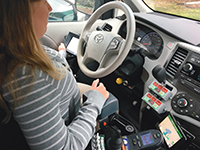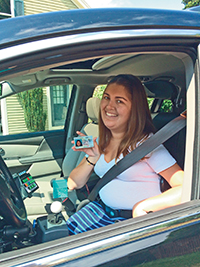
Mobility: In the Driver’s Seat

Learning to drive with adaptive equipment increases independence
Like many teenagers, Casey Stark wanted to learn to drive when she turned 16. But living with spinal muscular atrophy (SMA) and using a power wheelchair meant that preparing for and completing a driving test required extra planning.
Stark, who was a high-performing high school student, knew she could pass a written test, but she wondered how she was going to get behind the wheel. The cost of adapting a vehicle with hand controls and other driving aids was prohibitive, and she didn’t need to drive to manage her day-to-day student activities, so Stark put that dream on hold.

Three years later, when she needed to complete an internship for her studies in biology and cellular biology at the University of Wisconsin-Whitewater, Stark approached her local Division of Rehabilitation Services to ask about vehicle funding possibilities. Because her program was in another city, the office agreed she needed to drive to pursue her career goals. She qualified for funding, was evaluated for her adaptive equipment needs and spent a summer taking 120 hours of driving lessons. When she passed her driving test, she bought a Toyota Sienna minivan and waited several months for it to be outfitted with a ramp; a joystick hand control for acceleration, deceleration, braking and steering; and a dashboard computer monitor that handles parking, driving in reverse, windshield wiping and other common signal functions.
Stark, who now works as a research program coordinator at Medical College of Wisconsin, has been driving for five years. “It has been a huge asset for my independence,” she says. “I don’t have to rely on anyone or miss out on things. It helps me out professionally to be able to go to and from work by myself, and I can travel whenever I want to.”
Getting started
The process of learning to drive with adaptive equipment might seem intimidating, with multiple steps for evaluation and licensing, as well as funding challenges. This is true whether you are a new driver or one who is transitioning to driving with adaptive equipment. Fortunately, each state has resources to help drivers navigate the process. And the added mobility of independently traveling beyond where a power wheelchair or public transit can take you often makes it worth the time and effort.
To find out if you can use adaptive equipment to drive, look for a certified driver rehabilitation specialist (CDRS) in your area. The Association for Driver Rehabilitation Specialists (ADED) maintains a list of specialists who can evaluate your driving ability based on your range of motion, strength, coordination, vision and cognition to determine what you need to drive safely.
“The range of adaptive driving equipment is huge. Some people will require hand controls, which are a mechanical adaptation to the vehicle, and others can use an electronic computer-based joystick or an electronic steering wheel,” says Jenny Nordine, a registered and licensed occupational therapist and CDRS with Driving to Independence in Tempe, Ariz. When looking for an adaptive driving program, Nordine recommends calling and asking what kinds of adaptive equipment they work with to make sure they have what you need, whether that’s a car with hand controls or a wheelchair-accessible van.
Driving lessons
Once your CDRS understands what tools you need and your driving experience, it’s time for lessons. “The number of lessons differs based on the person,” says Nordine. “I think about driving as three main concepts: knowing the rules of the road, vehicle operation and defensive driving. With a brand new driver, I need to teach them all those things. With an experienced driver, I just need to teach them how to operate the vehicle in a new way. ”
That was the case for Cal Cooper, 69, who began driving with hand controls in 2016 after decades of driving conventionally. Cooper, who lives with a condition with symptoms consistent with Charcot-Marie-Tooth disease (CMT), felt increasing weakness and neuropathy in his feet. After being assessed for driving with hand controls, he took driving lessons and had hand controls installed on his vehicle.
“There was a learning curve, and the challenge was to retrain my brain not to react with my foot every time I wanted to brake,” he says. “I was a little anxious when I first drove in icy conditions or in heavy traffic, but now, six months later, I have no problem. My instructor helped me with the competence to do what I needed to do, and then I just needed to do it often enough to gain the confidence.”

Adaptation options
There is a wide range of adaptive driving equipment that can help people of varying abilities to drive safely, and as technology has improved and become more widely available, the number of people driving accessible vehicles has increased.
For drivers with no leg mobility, hand controls allow for braking and accelerating. Limited upper body mobility can be addressed with modifications such as a joystick that works a bit like a power wheelchair joystick. Drivers can use a control panel installed near the driver’s seat to operate the vehicle’s lights, horn, gears, heating and air conditioning.
Turning chairs are driver’s seats that rotate to allow a person to transfer into a vehicle from a wheelchair. There are also ramps and lowered-floor vehicles that will allow a power wheelchair user to drive the chair directly into the space where they will operate the vehicle. Tie-downs or locks secure the wheelchair so that it stays put while the vehicle is moving.
“Almost anything needed is available to make driving possible,” says Martine Kempf, the founder and CEO of KEMPF Inc., a California-based company that designs, manufactures, and installs adaptive driving equipment. While many people with limited mobility worry about their ability to drive safely, studies have found that traffic accident risk for drivers of accessible vehicles does not differ significantly from the risk for drivers in general. Kempf believes that drivers in this population are even more careful. “Those with disabilities know that if they don’t have a car, [they often] have no other method of transportation.”
“Driving has been such an enormous addition to my independence,” says Carolyn Barrett, 23, who lives with SMA, operates a power wheelchair and drives with hand controls. “The first time I took myself somewhere was the coolest moment I ever had. It was a whole new level of independence I’d never had before.”
Cheryl Alkon is a freelance writer based in Massachusetts.
The Road to Independent Driving
Each road to adaptive driving is different — some are bumpy, some are smooth and some have lots of twists and turns. Advocating for yourself often is the key to navigating that road, according to occupational therapist Jenny Nordine, who is a certified driver rehabilitation specialist (CDRS). While each person, diagnosis and situation is unique, many drivers follow a similar path to taking control of the wheel.
The Money Question
Paying for a driving evaluation, lessons and an accessible vehicle with the appropriate modifications can be costly. But there are options for financing the expense or at least offsetting some of the cost. The key is to be persistent and patient when researching all the possibilities.
Health insurance Check with your insurance provider to find out if your plan covers any part of the evaluation and training process or pays for adaptive equipment.
Government funding Resources vary by state. Contact your state’s vocational rehabilitation department and city and county social services to learn about state and local programs that may help provide financial assistance for all or part of the vehicle modification cost. Also, look for an Assistive Technology Act Program in your state.
Grants Some local nonprofits that advocate for individuals with disabilities have programs that help pay for adaptive equipment. Your state vocational rehabilitation department may be able to point you to resources in your community.
Rebates Many vehicle manufacturers offer rebates when you purchase a new vehicle and need modifications for accessibility. Your mobility dealer should be familiar with the available rebates.
Tax breaks Some states waive sales tax on the purchase of adaptive equipment if you have a doctor’s prescription. Also, look into whether the cost of your adaptive equipment is tax deductible.
Loans Some banks have auto loans specifically for individuals with disabilities, and some mobility dealers and conversion companies offer financing.
Resources for Driving
Learning to drive and purchasing an accessible vehicle is often a team effort. MDA can help by connecting you to community resources. Get in touch with trained resource specialists by contacting the MDA Resource Center at resourcecenter@mdausa.org or 800-572-1717.
Looking for More?
Check out Mobility: Choose the Right Wheels to learn more about learning to drive with adaptive equipment enhances mobility and independence for drivers with neuromuscular diseases. Also, read Accessible Vehicles Q&A to read answers to common questions about how to get the most value for your dollar when purchasing an accessible vehicle.
MDA Resource Center: We’re Here For You
Our trained specialists are here to provide one-on-one support for every part of your journey. Send a message below or call us at 1-833-ASK-MDA1 (1-833-275-6321). If you live outside the U.S., we may be able to connect you to muscular dystrophy groups in your area, but MDA programs are only available in the U.S.
Request Information